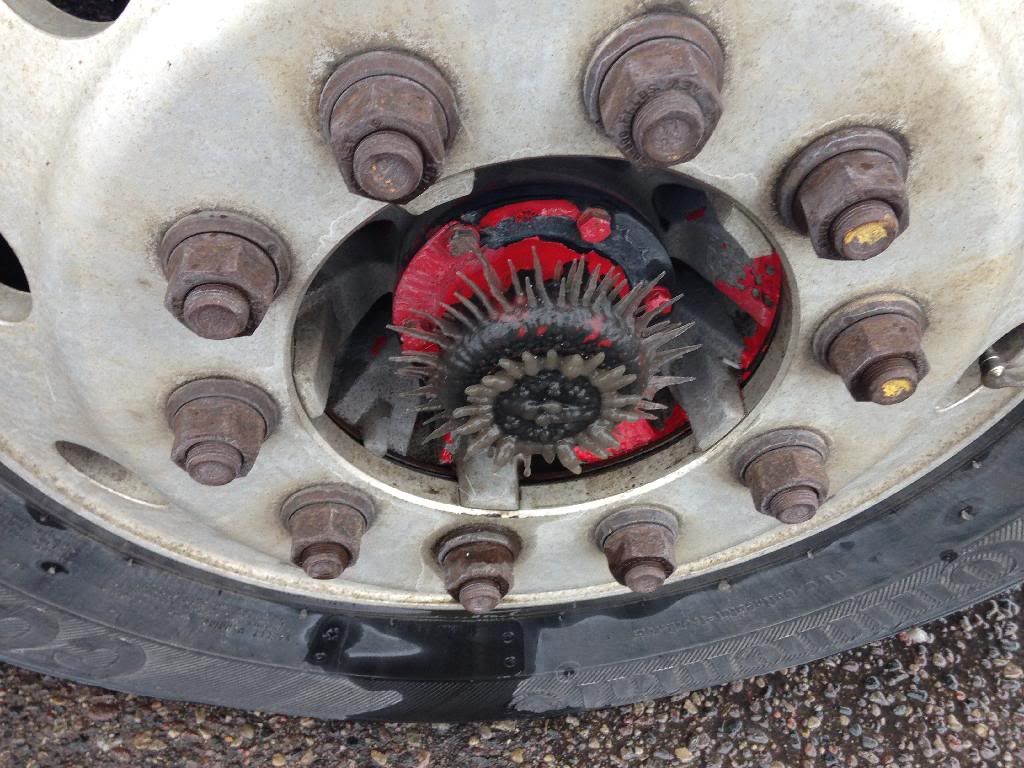Split Sleeper Berth Provision
Topic 2880 | Page 1

Yes you can but you 70 hour 8 day clock will make you stop at some point. Also, I did the math. You do not gain driving time like it seems at first glance. If you drive 11.5 hours (30 minute mandatory break)hand take a 10 hour break you will get more driving time. I started a tread not long ago with same type question. I will try to find it.

Thank you Wine Taster (that is, of course, off duty tasting, right?) I think I read that thread but was not familiar with HOS at all at the time so it went right over my head.
Stephen E. Birch
HOS:
Hours Of Service
HOS refers to the logbook hours of service regulations.
Ok I am a little confused after I re-read your post. Ok, you can take the 2 hour break and the 8 hour break in any order. Lets say you are starting fresh after 34 hour reset. You go on duty and drive an hour to a shipper to pick up a load. Let's say you started at 0600. You arrived at 0645 and got paperwork done and they start loading you at 0700. You go off duty while they load. You get done precisely at 0900 and start driving. So at this point you have 10 hours remaining on your drive clock and 11 hours remaining on your 14 hour clock.
So, you drive 8 hours and are forced to stop because of the mandatory 30 minute break. The time is 1700. You decide to call it a night and hit the sleeper for 8 hours. Before you went to sleep, you had 2 hours on your driving clock and 1.5 on your 14 hour clock. When you awake, you have met the split sleeper rule. It is 0100. You can now start your 14 hour clock and 11 hour drive clock from the end of the 2 hour break at 0900. That means after 0900, you drove 8 hours so you now have 3 hours to drive. Your 14 hour clock still has 6 hours because the 8 hours in the sleeper did not count against it.
You planned ahead and and now drive to get unloaded. You arrive at 0300. Well, they are closed until 0500. So, you go off duty for two hours. When you awake at 0500, wow, more time on the clock. Your clock starts running again but from the end of the 8 hour break at 0100. So, after 0100 you drove 2 hours. You now have 9 hours remaining to drive. Your 14 hour clock is still running. You have 10 hours remaining on your 14 hour clock.
You can keep this pattern up for a while but eventually you will run into the 70 hour / 8 day rule. I hope this helps. I, too am still learning it all. If anybody sees an error in my example, please point it out.
Shipper:
The customer who is shipping the freight. This is where the driver will pick up a load and then deliver it to the receiver or consignee.

One possible mis-statement (don't know if it changes any of the math) is saying you go "off duty" at the shipper while being loaded. It's my understanding that, while at a customer, you must be either "on duty" or "in the sleeper berth". By off duty did you mean sleeper berth?
Shipper:
The customer who is shipping the freight. This is where the driver will pick up a load and then deliver it to the receiver or consignee.
Sleeper Berth:
The portion of the tractor behind the seats which acts as the "living space" for the driver. It generally contains a bed (or bunk beds), cabinets, lights, temperature control knobs, and 12 volt plugs for power.

ATXJEHU, (how does one pronounce that?) I think from all of the examples that "off duty" counts toward the "split" `10 hour requirement. Several of the examples had 2 hour "off duty" segments and one had a combo of 5 hours in the "berth" and 5 hours simply "off duty" to make up a 10 hour segment. Is that what you were asking? Maybe not . . . I am just now studying to get the HOS stuff down . . . maybe your question was asking if a driver can be "off duty" while at a customer's location or has to be in the "berth" or "on duty" with no other choice available . . .
Stephen E. Birch
HOS:
Hours Of Service
HOS refers to the logbook hours of service regulations.
It would not matter. The two hour break can be off duty or in sleeper. The 8 hour MUST be in sleeper. That is the way I understand it.
Stephen, you can not break it up 5 and 5. You can do 8 in sleeper and 5 off duty or sleeper. For the split rule to work, one of the breaks must be at least 8 hours in the sleeper. It would make the rule so much easier if you could split the 10 hours up anyway you wanted.

Yes, it does not matter as far as the clock is concerned as to whether you are off duty or in the sleeper berth , but my point was/is that, once you are checked in at the customer, your choice is limited to being either on duty or in the sleeper berth. At least, that's the way I understand it.
Sleeper Berth:
The portion of the tractor behind the seats which acts as the "living space" for the driver. It generally contains a bed (or bunk beds), cabinets, lights, temperature control knobs, and 12 volt plugs for power.

Yes, it does not matter as far as the clock is concerned as to whether you are off duty or in the sleeper berth , but my point was/is that, once you are checked in at the customer, your choice is limited to being either on duty or in the sleeper berth. At least, that's the way I understand it.
At a customers dock it's either on duty or sleeper berth. If you are off duty that means you are out of the truck and have zero responsibility for the truck during unloading which is never the case.
Sleeper Berth:
The portion of the tractor behind the seats which acts as the "living space" for the driver. It generally contains a bed (or bunk beds), cabinets, lights, temperature control knobs, and 12 volt plugs for power.

Yes, it does not matter as far as the clock is concerned as to whether you are off duty or in the sleeper berth , but my point was/is that, once you are checked in at the customer, your choice is limited to being either on duty or in the sleeper berth. At least, that's the way I understand it.
At a customers dock it's either on duty or sleeper berth. If you are off duty that means you are out of the truck and have zero responsibility for the truck during unloading which is never the case.
Thanks guys for clarifying the "status" of the driver while at a customer's property . . . also, the 5/5 (off duty/berth hours) I referred to earlier in the CDL training was for the "10 consecutive hours off duty" that resets the 11 & 14 hour limits . . . it didn't refer to the "split" that can be done for the berth/off duty 10 hours . . .
CDL:
Commercial Driver's License (CDL)
A CDL is required to drive any of the following vehicles:
- Any combination of vehicles with a gross combined weight rating (GCWR) of 26,001 or more pounds, providing the gross vehicle weight rating (GVWR) of the vehicle being towed is in excess of 10,000 pounds.
- Any single vehicle with a GVWR of 26,001 or more pounds, or any such vehicle towing another not in excess of 10,000 pounds.
- Any vehicle, regardless of size, designed to transport 16 or more persons, including the driver.
- Any vehicle required by federal regulations to be placarded while transporting hazardous materials.
Sleeper Berth:
The portion of the tractor behind the seats which acts as the "living space" for the driver. It generally contains a bed (or bunk beds), cabinets, lights, temperature control knobs, and 12 volt plugs for power.
New Reply:
New! Check out our help videos for a better understanding of our forum features

















Preview:
This topic has the following tags:
CDL Training Logbook Questions







 TT On Facebook
TT On Facebook
There is an example of 2 days of a log book in the "Log Book" section of the CDL training with the following explanation:
" After 10 consecutive hours off duty, the driver had 11 hours of driving time available beginning at 2:00 a.m. on Day 1. The driver used those 11 hours by 4:00 p.m. on Day 1, when he or she entered the sleeper berth for 8 consecutive hours. Because the driver accumulated at least 10 hours of rest using a combination of at least 8 consecutive hours in a sleeper berth (4:00 p.m. to Midnight on Day 1) and another break of at least 2 consecutive hours (8:00 a.m. to 10:00 a.m. on Day 1), he or she was eligible for the split sleeper berth provision. This moves the calculation point to the end of the first of the two periods of rest, or 10:00 a.m. on Day 1. Starting the calculation from there, the driver accumulated another 10 hours of driving by 5:00 a.m. on Day 2. By 7:00 a.m. on Day 2, the driver accumulated another pair of qualifying breaks totaling at least 10 hours [4:00 p.m. to Midnight on Day 1 (8 hours) and 5:00 a.m. to 7:00 a.m. on Day 2 (2 hours)]. This moves the calculation point again, to the end of the first of the two breaks, or Midnight beginning Day 2. From there, the driver accumulated another 10 hours of driving by 1:00 p.m. on Day 2. The pattern of 8/2 split sleeper berth provisions continued, with no 11 hour violations."
If we label the first 2-hour break "A" (8:00 a.m. to 10:00 a.m. on Day 1) and the second 8-hour break as "B" (4:00 p.m. to Midnight on Day 1) so far so good. However the next 10 hour rest period is achieved by combining "B" (4:00 p.m. to Midnight on Day 1) with "C" (5:00 a.m. to 7:00 a.m. on Day 2 ) which means two consecutive 10-hour breaks ("Splits") were achieved by combing "A+B" and then "B+C" . . . does that mean you can keep up such a pattern indefinitely? i.e. "A+B" followed by "B+C" and then "C+D" and then "D+E", etc., etc., grouping each half of the "split" first forward and then backwards in time? I'm confused . . .
Stephen E. Birch
CDL:
Commercial Driver's License (CDL)
A CDL is required to drive any of the following vehicles:
Sleeper Berth:
The portion of the tractor behind the seats which acts as the "living space" for the driver. It generally contains a bed (or bunk beds), cabinets, lights, temperature control knobs, and 12 volt plugs for power.
HOS:
Hours Of Service
HOS refers to the logbook hours of service regulations.OWI:
Operating While Intoxicated